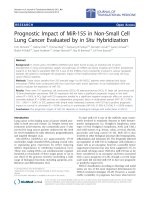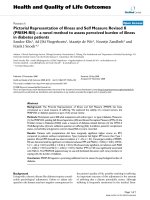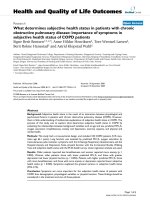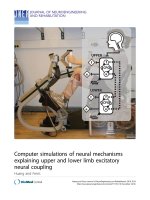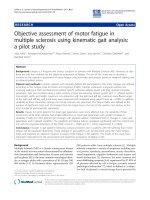Báo cáo hóa học: "Dermal absorption of aromatic amines in workers with different skin lesions: a report on 4 cases" doc
Bạn đang xem bản rút gọn của tài liệu. Xem và tải ngay bản đầy đủ của tài liệu tại đây (236.02 KB, 4 trang )
BioMed Central
Page 1 of 4
(page number not for citation purposes)
Journal of Occupational Medicine
and Toxicology
Open Access
Case report
Dermal absorption of aromatic amines in workers with different
skin lesions: a report on 4 cases
Gintautas Korinth*
1
, Tobias Weiss
2
, Jürgen Angerer
1
and Hans Drexler
1
Address:
1
Institute and Out-Patient Clinic of Occupational, Social and Environmental Medicine, University of Erlangen-Nuremberg, Schillerstrasse
25/29, D-91054 Erlangen, Germany and
2
Research Institute for Occupational Medicine of the Ruhr University of Bochum (BGFA), Bürkle-de-la-
Camp Platz 1, D-44789 Bochum, Germany
Email: Gintautas Korinth* - ; Tobias Weiss - ;
Jürgen Angerer - ; Hans Drexler -
* Corresponding author
Abstract
There are only few studies about the relationship of skin lesions and the percutaneous uptake of
hazardous substances in exposed workers. Several aromatic amines are well known carcinogens
for humans and/or animals. This case report emphasizes the relevance of dermal absorption of the
aromatic amine ortho-toluidine considering four workers with different skin status (healthy,
erythematous and burned skin as well as dishydrotic eczema) during the vulcanisation process of
rubber products in a components supplier plant for automobile industry. The results of our case
report show that dermal absorption of o-toluidine through damaged epidermal barrier is
significantly higher than through healthy skin.
Background
The exposure to aromatic amines (AA) continues to be a
serious problem. Bladder cancer caused by exposure to AA
is a common occupational cancer. The greatest problem
from the point of view of occupational hygiene is, in spite
of the standard technical protection measures, that AA are
well absorbed through the skin.
AA, respectively the intermediates of AA, are not substitut-
able in various industries until now. Ortho-toluidine (o-
toluidine) is classified by the International Agency for
Research on Cancer (IARC) as probably carcinogenic to
humans [1]. In Germany this compound is considered to
be carcinogenic for man [2].
In automobile industry o-toluidine is contained in di-
ortho-tolylguanidine used as accelerator for the vulcanisa-
tion of rubber products. In the present case report we eval-
uate the dermal absorption of o-toluidine in workers who
performed vulcanisation of rubber articles.
Methods
Study population
In a components supplier plant for the automobile indus-
try we examined all workers (n = 4, male, response rate:
100%) involved in vulcanising hydraulic rubber articles.
During this process the workers were exposed by inhala-
tion and/or dermal contact to o-toluidine released from
vulcanisation accelerators. We asked the workers to report
on general workplace conditions, private and occupa-
tional risk factors, skin complaints, history of skin dis-
eases and the use of personal protective equipment
(breathing protection masks, gloves, skin barrier and skin
care creams) by means of a standardized, self-adminis-
tered questionnaire.
Published: 19 July 2006
Journal of Occupational Medicine and Toxicology 2006, 1:17 doi:10.1186/1745-6673-1-17
Received: 20 March 2006
Accepted: 19 July 2006
This article is available from: />© 2006 Korinth et al; licensee BioMed Central Ltd.
This is an Open Access article distributed under the terms of the Creative Commons Attribution License ( />),
which permits unrestricted use, distribution, and reproduction in any medium, provided the original work is properly cited.
Journal of Occupational Medicine and Toxicology 2006, 1:17 />Page 2 of 4
(page number not for citation purposes)
Clinical examination of skin
A dermatologically trained physician screened the skin of
the workers for lesions in accordance with a recently pub-
lished study [3]. Lesions considered included erythema,
scaling and other pathological findings such as fissures,
vesicles or callosities, categorized also according to ana-
tomical site. The classification of erythema and skin scal-
ing was performed immediately after clinical
examination. Hence, the observer was blind to type and
intensity of exposure when evaluating the skin.
External exposure and biological monitoring
We measured the concentration of o-toluidine in the
workplace air by personal air monitoring (NIOSH
method No. 2017) [4]. Internal exposure in workers was
determined by analysis of o-toluidine in post-shift urine
using gas chromatography and mass selective detection
with negative chemical ionisation [5,6]. As a rule, this is
the optimal time point for urine sampling to assess the
exposure over a working day [2]. For the direct compari-
son of the internal exposure in workers related to the
external exposure we used the quotient RIE (relative inter-
nal exposure) as described by Drexler et al. [7]:
We regard this quotient as a measure of the internal expo-
sure related to the individual exposure. On this basis, we
were able to compare the individual relationships of inter-
nal to external exposure. Additionally we assessed the
influence of smoking on internal exposure by measure-
ment of cotinine in the urine of the workers. In view of the
explanatory nature of our data, we used the RIE index to
compare the values of external and internal exposure
between the workers.
Results and discussion
The results of personal air and biological monitoring to o-
toluidine are presented in Table 1. Over the whole shift (8
hours), the workers were exposed to AA by inhalation and
by dermal contact from the gaseous phase. The German
threshold limit value for o-toluidine in the air (500 µg/
m
3
) was not exceeded [2]. However, the concentration of
o-toluidine in the workplace air was rather high as indi-
cated by a factor of at least 25 compared to values found
in indoor and outdoor air [8,9]. Cotinine values in urine
showed that workers no. 3 and 4 were non-smokers, prob-
ably not even exposed by passive smoking. Therefore,
comparing the urine values presented in our case report
with the background exposure level of the German gen-
eral population (range: <0.05 – 3.1 µg/l, median: 0.12 µg/
l) we can assume that the internal exposure to o-toluidine
in all workers resulted primarily from occupational expo-
sure [5].
The skin status as well as skin protection and care can
affect the uptake of AA. None of workers was equipped
with breathing protection masks against inhalative uptake
of AA. All four workers wore thick cloth gloves during con-
tact to the vulcanised rubber tubes. The dermal contact of
the hands to AA was very similar for all workers and
existed with short interruptions over the whole work shift.
During the wearing of cloth gloves (210 – 240 minutes)
the hands were occluded also in a wet environment. The
cloth gloves were replaced during the shift 7 – 12 times
after being wetted by the work. We did not observe atopic
skin diathesis in the workers. One worker (no. 1) had
healthy skin. However, the three other workers had skin
lesions of different kind and severity. While the skin of
worker no. 2 was affected only by a slight erythema on the
hands, in worker no. 3 we observed several sites on hands
with burns (though covered by scab or visible as redness)
caused by accidental contacts to hot (about 180°C) pipes
serving to form rubber tubes during the vulcanisation
process. The most severe skin lesions were observed in
worker no. 4 suffering from dyshidrotic eczema for more
than 16 years and moderate erythematous lesions on
hands and forearms.
The results show that the RIE depends on skin condition
of the workers (Fig. 1). The external inhalative exposure to
o-toluidine in the worker suffering from dyshidrotic
eczema was the lowest of all workers (by a factor of 3.5
lower than in highest exposed worker), but he showed the
second highest RIE (Fig. 1). The external inhalative expo-
sure to o-toluidine in the worker with healthy skin was the
second highest. However, he showed the lowest RIE of all
workers, despite the fact that he was additionally exposed
to AA from heavy smoking (Table 1). Worker no. 2 (mild
erythema) was the highest exposed worker by inhalation
(at the factor of 3.5 higher than the worker with dyshid-
RIE
Chemical concentration in urine g l
Chemical concent
=
(/)
µ
rration he air g m in t (/)
µ
3
Table 1: Values from personal air and biological monitoring.
Variables Worker no. 1 Worker no. 2 Worker no. 3 Worker no. 4
Skin condition of hands Healthy skin Mild erythema Burns on hands Dyshidrotic eczema
o-Toluidine in the air (µg/m
3
) 58.29 93.93 32.73 26.63
o-Toluidine in urine (µg/l) 74.83 242.88 64.36 54.65
Cotinine in urine (µg/l) 4471 µg/L (= smoker) 741 µg/L (= smoker) < 5 µg/L (= non-smoker) < 5 µg/L (= non-smoker)
Journal of Occupational Medicine and Toxicology 2006, 1:17 />Page 3 of 4
(page number not for citation purposes)
rotic eczema). However, this high air exposure did not
lead to a proportional increase of RIE. These slight ery-
thematous changes in the worker no. 2 do not seem to
have a significant effect on the skin barrier preventing the
dermal uptake of the lipophilic o-toluidine.
It is well known that damaged epidermal barrier leads to
a higher dermal absorption of chemicals [10,11]. Internal
exposure to solvents miscible in water is higher in workers
with skin lesions than in workers with healthy skin [3,7].
Moreover, recently in vitro experiments showed that o-
toluidine penetrates through human skin to a high extent.
These experiments were based on a finite exposure dose in
order to mimic occupationally relevant situations [12].
Therefore, due to the low vapour pressure, the internal
exposure of workers to o-toluidine in the present study
should result predominantly from dermal absorption.
In our study, a relationship between skin lesions and the
internal exposure to the AA o-toluidine was established.
The uptake of o-toluidine was relatively higher in workers
with damaged epidermal barrier such as skin burns, par-
ticularly with dyshidrotic eczema, than in workers with
healthy or slight erythematous skin. A proportional rela-
tionship between the airborne levels of o-toluidine and
the difference of RIE (Fig. 1) emphasize the importance of
its dermal absorption in workers. These findings are in
accordance with our previous studies with a glycol ether
and carbon disulfide [3,7]. From an occupational medical
point of view the higher uptake of chemicals in workers
with impaired skin barrier cannot be ignored. Gloves (the
material itself or the frequency of replacement) and skin
creams do not seem to be sufficient to achieve an efficient
protection. However, due to the small study group, the
impact of various occupational exposure factors on der-
mal absorption of o-toluidine cannot be conclusively
assessed. Solely the worker with dyshidrotic eczema used
skin barrier creams at the workplace. He and the worker
with healthy skin used skin care creams in the plant. The
protective effects of skin creams to reduce the dermal
absorption were not evident in our study group. On the
contrary, there are hints that barrier creams might
enhance the dermal absorption [13].
In our study, the workers with the highest internal expo-
sure (RIE) coincidentally had the lowest airborne expo-
sure. From the perspective of preventive occupational
medicine, we have to assume the opposite to be the case:
occupational exposure scenarios that workers with severe
skin lesions have a high inhalative exposure. This would
lead to a disproportionately high o-toluidine uptake that
is not sufficiently reflected by sole determinations of o-
toluidine in air. Therefore we recommend to perform bio-
logical monitoring for workers with skin diseases. The
assessment of haemoglobin adducts – a long-term param-
eter reflecting the cumulative internal exposure of about
the last 4 months in accordance with the lifetime of the
erythrocytes – is a powerful tool for the surveillance of
occupationally exposed workers. Only the approach of
biological monitoring can assess the uptake of hazardous
substances by all routes.
Conclusion
Our case report shows that the internal exposure to AA
increases in workers with impaired epidermal barrier.
When the dermal contact to hazardous substances at
workplaces cannot be avoided, respectively a sufficient
exposure assessment to prevent the dermal uptake is not
practicable, biological monitoring of workers can help to
monitor the total body burden.
Declaration of competing interests
The author(s) declare that they have no competing inter-
ests.
Abbreviations
AA; aromatic amines
IARC; International Agency for Research on Cancer
RIE; relative internal exposure
Authors' contributions
GK and TW were the principal investigators. GK examined
the workers and drafted the manuscript. TW and JA were
responsible for analyses of personal air and biological
monitoring. TW, JA and HD revised critically the manu-
Relationship between the concentration of o-toluidine in ambient air at the workplace and the relative internal expo-sure (RIE)Figure 1
Relationship between the concentration of o-toluidine in
ambient air at the workplace and the relative internal expo-
sure (RIE).
Publish with BioMed Central and every
scientist can read your work free of charge
"BioMed Central will be the most significant development for
disseminating the results of biomedical research in our lifetime."
Sir Paul Nurse, Cancer Research UK
Your research papers will be:
available free of charge to the entire biomedical community
peer reviewed and published immediately upon acceptance
cited in PubMed and archived on PubMed Central
yours — you keep the copyright
Submit your manuscript here:
/>BioMedcentral
Journal of Occupational Medicine and Toxicology 2006, 1:17 />Page 4 of 4
(page number not for citation purposes)
script. All authors read and approved the final manu-
script.
Acknowledgements
This study was sponsored by grants of the institution for statutory accident
insurance of the German chemical industry (Berufsgenossenschaft der che-
mischen Industrie). The authors also wish to thank their colleague Holger
M. Koch for his valuable assistance in preparing the manuscript.
References
1. IARC: Monographs on the Evaluation of Carcinogenic Risks
to Humans. Some Industrial Chemicals. Volume 77. IARC Sci-
entific Press; 2000.
2. DFG (Deutsche Forschungsgemeinschaft): List of MAK and BAT
values 2005. Wiley-VCH, Weinheim, Germany; report no. 41;
2005.
3. Korinth G, Göen T, Lakemeyer M, Broding HC, Drexler H: Skin
strain and its influence on systemic exposure to a glycol
ether in offset printing workers. Contact Dermatitis 2003,
49:248-254.
4. NIOSH: Aniline, o-toluidine, and nitrobenzene. Method 2005.
In NIOSH Manual of Analytical Methods 4th edition. Edited by: Eller PM,
Cassinelli ME. National Institute for Occupational Safety and Health
(NIOSH), Publication No. 98-119, 2nd Supplement, Cincinnati; 1998.
5. Weiss T, Angerer J: Simultaneous determination of various
aromatic amines and metabolites of aromatic nitro com-
pounds in urine for low level exposure using gas chromatog-
raphy-mass spectrometry. J Chromatogr B Analyt Technol Biomed
Life Sci 2002, 778:179-192.
6. Weiss T: Entwicklung und Anwendung analytischer Meth-
oden zum Biologischen Monitoring und Biochemischen
Effektmonitoring von aromatischen Aminen im Rahmen
arbeits- und umweltmedizinischer Fragestellungen. Disserta-
tion University of Erlangen-Nuremberg; 2005. (in German).
7. Drexler H, Göen T, Angerer J: Carbon disulphide. II. Investiga-
tions on the uptake of CS
2
and the excretion of its metabo-
lite 2-thiothiazolidine-4-carboxylic acid after occupational
exposure. Int Arch Occup Environ Health 1995, 67:5-10.
8. Palmiotto G, Pieraccini G, Moneti G, Dolara P: Determination of
the levels of aromatic amines in indoor and outdoor air in
Italy. Chemosphere 2001, 43:355-361.
9. Luceri F, Pieraccini G, Moneti G, Dolara P: Primary aromatic
amines from side-stream cigarette smoke are common con-
taminants of indoor air. Toxicol Ind Health 1993, 9:405-413.
10. Bronaugh RL, Weingarten DP, Lowe NJ: Differential rates of per-
cutaneous absorption through the eczematous and normal
skin of a monkey. J Invest Dermatol 1986, 87:451-453.
11. Nielsen JB: Percutaneous penetration through slightly dam-
aged skin. Arch Dermatol Res 2005, 296:560-567.
12. Lüersen L, Wellner T, Koch HM, Angerer J, Drexler H, Korinth G:
Penetration of β-naphthylamine and o-toluidine through
human skin in vitro. Arch Toxicol in press. 2006, Apr 5.
13. Korinth G, Geh S, Schaller KH, Drexler H: In vitro evaluation of
the efficacy of skin barrier creams and protective gloves on
percutaneous absorption of industrial solvents. Int Arch Occup
Environ Health 2003, 76:382-386.




